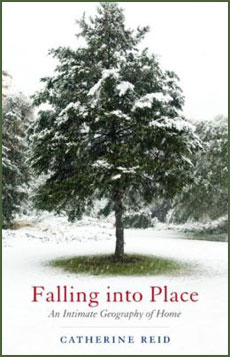"On the way home, I pause near a favorite stand of hemlock, remembering the different things Karl and I noticed on those days when we wandered along the trails above this valley. It was with Karl that I became aware of how often I look toward the ground, hunting for stories in tracks or scat, fur or feathers; in contrast, Karl looked up, searching for stories far older than passing birds or animals or the evidence of ripe crops. The real histories are recorded higher up, he would point out, like global weather patterns, effects of pollution, and markers of lean or good times in crabbed or healthy growth.
"I arch back now and look for those signs but see mostly the paradox of hemlocks. The trees thrive in harsh places, often north-facing slopes, where the land is rocky and uneven, the light perpetually muted. Yet there is a tenderness about hemlocks, written all over their rough-plated length. Thick bark contrasts with delicate limbs, each lined with blunt needles that appear lacy and fine. And in a strong enough breeze, the knobby branches furl back, exposing pale undersides that look inviting and soft.
"The trees have always been a part of this landscape, companions on shaded ridges and alongside cool rivers. Such fondness makes it hard to accept that they might one day be gone, and I brush one as I pass, for the comfort of its smell. I have no idea how old the tree is, as it's impossible to estimate hemlock age based on height. The species can tolerate shade, which means that for decades they might barely grow, until at last there is light — a neighboring tree dies or is taken down by a saw or storm — and the hemlock undergoes a growth spurt, pushing high into the upper story. Only a core sample can reveal the actual age, and on some of these hard-to-reach slopes, researchers are discovering trees more than four hundred years old.
"Little else in these woods can compare with that life span; few other species contain so many tales. A tree of that age knew the native peoples who once traveled this land, along with the elk and wolves and mile-long flocks of passenger pigeons. A four-hundred-year-old hemlock witnessed the first carts and carriages, the earliest tractors and trolleys and trains. It felt the vibrations of rifles and church bells, chainsaws and waterwheels, and jets traveling so fast they cracked sound waves above it. It experienced years when snow fell every month, when ash from distant volcanoes coated its limbs, and when prolonged droughts made it retreat into stunned and dormant states. It watched as the surrounding hills were stripped of trees and then left to grow into forest again, and it felt the pressure of acid rain, of a thinning ozone layer, of the sheer weight of human life pressing down on the planet.
"Yet its rich trove of stories is about to cease gathering. A new and tiny parasite has appeared on the scene, as lethal as the other waves of disease to pass this way, HIV and the various cancers that are felling friends like Karl.
"The hemlock's bane — woolly adelgids — recently arrived from Japan, where two insect predators kept them in check. But here, according to Karl, the hemlocks are defenseless, and all of them may be gone within the next ten or so years. We will know the adelgids have taken hold when bits of white wool appear on the branches, or when nymphs stream from the eggs in April or May, sucking sap as they travel through tender new needles. Once the tree has been infested, vital sap drawn from its core, it dies a slow death, from its limbs to the crown. Four years, Karl said, is the typical life span once adelgids have begun to suck. He had less than a year.
"I don't know how we'll mourn the hemlocks' passing, whether we will have organized laments on town commons or retreat into private moments. It's not as though we haven't had practice; we know what it's like to have a landscape of skeletons, left after disease decimated both the chestnuts and elms. But it takes time to get used to an emptied space, a chair suddenly vacant at the table, a phone that will no longer be answered. Each loss seems to ratchet up the risk we take when falling in love with someone new."
